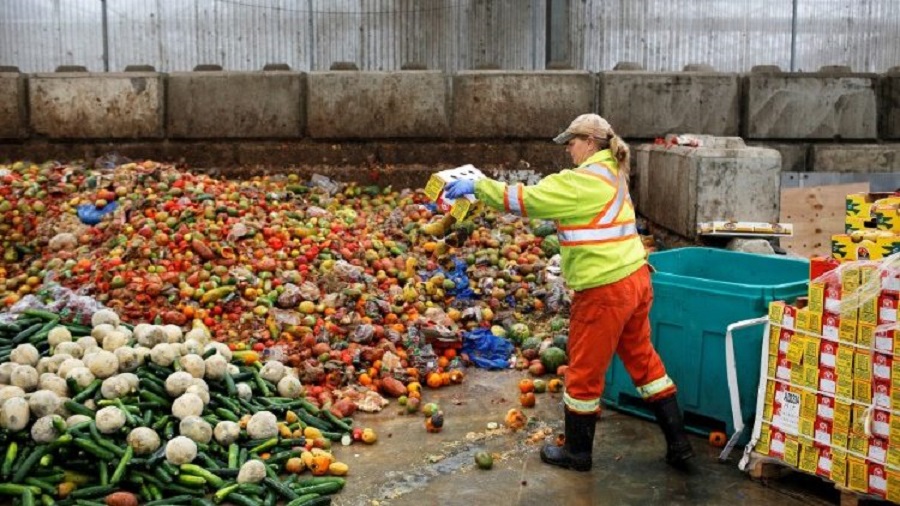Why Do People Waste Food?
Understanding food waste is not a big problem in a society where millions go to bed hungry; it is a moral duty. Waste food is a complicated issue that has an impact on economies, ecology, and cultures all around the world. This in-depth article will go into the complexities of this issue, providing light on what constitutes waste food, its worrying numbers, its causes, and the proactive actions we can take to counteract it.
Definition of Food Waste:

Before digging into the causes, defining waste food is critical. Food waste is defined as edible products abandoned throughout production, distribution, and consumption. Fruits, vegetables, dairy products, cereals, and meat are among the thrown commodities. It is not only food that ends up in the garbage at home but also produce that is left unharvested in fields, items that are thrown due to cosmetic flaws, and extra inventory that never reaches consumers.
The Staggering Statistics:
According to the Food and Agriculture Organization (FAO), approximately one-third of all food produced worldwide, which amounts to a staggering 1.3 billion tons annually, is discarded.
The sheer volume of wasted food, equivalent to 1.3 billion tons, is challenging to grasp. To put it in perspective, this amount could fill the Empire State Building in New York City over 150 times! Such massive waste is particularly distressing, considering millions worldwide suffer from hunger and malnutrition.
Types of Food Waste:
In a world where food security is a pressing issue, it’s disheartening to acknowledge the vast amount of food that goes to waste daily. Food waste encompasses various categories, each contributing to this global problem uniquely. Let’s explore these categories to gain a deeper understanding.
1. Pre-Harvest Food Waste
Pre-harvest waste food refers to the food that never gets harvested in the first place. This type of waste occurs due to various factors, including overproduction, weather-related issues, and pest infestations. Let’s break down these factors:
- Overproduction:
Overproduction is a common challenge in agriculture. Farmers often grow more crops than are needed to meet demand. When these surplus crops go unharvested, they contribute to pre-harvest food waste.
- Weather-Related Issues:
Weather can be unpredictable and harsh, causing significant damage to crops. Floods, droughts, hurricanes, and other extreme weather events can devastate entire harvests, leading to massive food losses.
- Pest Infestations:
Pests like insects, rodents, and birds can wreak havoc on crops. A substantial portion of the harvest can be rendered inedible without effective pest control measures.
2. Post-Harvest Food Waste
Post-harvest waste food occurs after the crops have been harvested but before they reach consumers. This category encompasses food losses during transportation, storage, and distribution. Let’s delve deeper:
- Spoilage:
During transportation and storage, food can spoil due to inadequate temperature control, humidity, or exposure to contaminants. This spoilage results in the disposal of otherwise edible food.
- Contamination:
Contamination can happen anywhere in the supply chain. Food that comes into contact with harmful pathogens or chemicals may need to be discarded to ensure consumer safety.
- Mishandling:
Improper food handling during transportation and distribution can lead to physical damage, rendering it unsuitable for consumption.
3. Retail and Consumer Food Waste
Retailers, restaurants, and households play a significant role in contributing to waste food. Food that goes unsold in grocery stores, gets discarded in restaurants, or is thrown away in households contributes to this category.
- Unsold Inventory:
Grocery stores often discard products approaching their expiration date or are slightly damaged, even if they are still safe to consume.
- Restaurant Waste:
Restaurants frequently generate food waste through portions exceeding customers’ appetites or discarding leftovers.
- Household Food Waste:
At home, consumers often dispose of food that has gone bad due to neglect or because they prepared more than they could consume.
The Reasons Behind Food Waste:
Food waste is a pressing global issue that contributes to hunger and has adverse environmental and economic consequences. To address this problem effectively, it’s imperative to understand the underlying reasons behind waste food. Here, we will look into the multifaceted causes of waste food, exploring why it happens and how it impacts society, all while considering the importance of sustainable living.
1. Overproduction: A Growing Dilemma:
One of the primary culprits behind food waste is overproduction. The relentless drive to meet the ever-increasing demand for food often leads to the cultivation or manufacturing of more food than is necessary. This excess production often goes to waste, significantly damaging our resources.
Overproduction stems from the fear of shortages and the desire to ensure enough food is always available. Farmers and manufacturers tend to produce surplus quantities as a precautionary measure. Unfortunately, this surplus often goes unsold and unused, ending up in landfills. This practice not only wastes valuable resources but also contributes to environmental degradation.
2. Inefficient Supply Chains:
Food follows a long and intricate journey from farm to table, and there is potential for waste food at every stage of this journey. Inefficient supply chains are a significant contributor to this problem. The complexity of these supply chains can result in food spoilage and wastage during transportation and storage.
Produce may spend extended periods in transit or storage facilities, often in suboptimal conditions. As a result, fruits and vegetables may ripen too quickly, dairy products expire, and meat and seafood spoil before reaching the consumer. Inefficient supply chains not only lead to economic losses but also exacerbate the problem of food scarcity.
3. Consumer Behavior: A Tale of Excess:
Consumer behavior plays a significant role in the perpetuation of waste food. Consumers frequently buy more food than they can reasonably consume, often influenced by bulk-buying promotions and a desire to stockpile. This excessive purchasing is driven by various factors, including societal pressure to have well-stocked pantries and confusion over expiration dates.
Moreover, consumers often discard perfectly edible items prematurely due to a lack of understanding about food quality and safety. The misconception that food is no longer suitable for consumption once it expires is a common but erroneous belief. This misinterpretation contributes to a significant amount of food waste in households.
4. Retail Practices: The Pursuit of Perfection:
Retail practices also contribute to the problem of waste food. Strict cosmetic standards for produce mean that suppliers and retailers often discard fruits and vegetables that don’t meet specific size, shape, or color criteria. This “cosmetic imperfection” results in delicious food being rejected solely for aesthetic reasons.
Additionally, promotions encouraging bulk buying can lead to substantial retail food waste. While these promotions may offer cost savings to consumers, they also encourage the purchase of more food than can reasonably be consumed, ultimately leading to waste.
Solutions to Reduce Food Waste
Food preservation techniques, donations, food banks, and government initiatives are just a few ways to reduce the staggering amount of wasted food daily significantly. Here, we will see these solutions, explore their effectiveness, and suggest additional strategies to combat this pressing issue.
1. Food Preservation Techniques:
Food preservation prevents food from spoiling or becoming inedible, extending its shelf life. This process plays a pivotal role in reducing waste food.
- Home Food Preservation:
Educating individuals about food preservation techniques can significantly reduce food waste at home. Encouraging households to adopt simple methods like canning, freezing, and dehydrating can help prolong the freshness of food.
- Reducing Food Spoilage:
Understanding the causes of food spoilage, such as improper storage and handling, can empower people to minimize waste. Proper storage techniques like using airtight containers and refrigeration are essential.
- Innovative Preservation Methods:
Highlighting innovative methods like vacuum sealing, pickling, and fermenting can inspire individuals to explore new ways to extend the life of their food items.
2. Donations and Food Banks:
Redirecting surplus food to those in need through donations and food banks can make a substantial difference. This act reduces waste and helps alleviate hunger and food insecurity.
- Food Recovery Programs:
Discussing the importance of food recovery programs that collect and distribute excess food from restaurants, supermarkets, and events to charitable organizations can shed light on the impact of such initiatives.
- Encouraging Volunteering:
Promoting volunteering within communities to support food banks and organizations that distribute surplus food emphasizes individuals’ role in combating food waste.
3. Government Initiatives:
Governments can implement policies and incentives to encourage businesses and individuals to reduce waste food. These measures may include tax benefits for food donations and regulations on expiration date labeling.
- Public Awareness Campaigns:
Highlighting the significance of public awareness campaigns to educate citizens about food waste and its environmental consequences can lead to behavior change.
- Collaborations with Businesses:
Governments can collaborate with businesses to develop sustainable practices, such as composting and recycling, to manage waste food effectively.
4. Additional Strategies:
Promoting the establishment of community gardens can help individuals grow their food, fostering a deeper appreciation for it and reducing reliance on store-bought items.
- Meal Planning Apps:
Introducing meal-planning apps that suggest recipes based on available ingredients can minimize waste food by encouraging consumers to use what they have.
- Food Waste Tracking:
Encouraging people to track their waste food at home through apps or journals can increase awareness and accountability.
- Sustainable Packaging:
Advocating for sustainable packaging solutions in the food industry can reduce the environmental impact of food products.
- Food Redistribution Apps:
Supporting the development of food redistribution apps that connect surplus food with those in need can facilitate efficient food rescue efforts.
Conclusion
Food waste is a global problem with far-reaching consequences for the environment, society, and the economy. Understanding the reasons behind it is the first step towards finding solutions. By addressing the psychology, societal norms, environmental impact, and economic factors, we can collectively work towards a future where wasting food is no longer a norm.
Reducing waste food is a multifaceted challenge requiring concerted effort from individuals, communities, and governments. By implementing the strategies discussed in this article and embracing innovative solutions, we can work towards a more sustainable future where food is cherished and utilized to its fullest potential.
FAQ’s:
Food waste is defined as edible products that are abandoned during manufacturing, distribution, and consumption.
Around one-third of all food produced globally or around 1.3 billion tons, is wasted annually.
Individuals may decrease food waste by studying food preservation techniques and practicing portion control.
Governments may enact rules and incentivize companies and individuals to decrease food waste.
Methane, a powerful greenhouse gas contributing to climate change and environmental degradation, is produced by food waste in landfills.
Food waste is a global issue since it leads to poverty and has negative environmental and economic implications. Food waste depletes resources and contributes to greenhouse gas emissions.
Individuals may limit food waste at home by planning meals, purchasing what is required, and storing food appropriately to extend its shelf life. Understanding food expiry dates might also assist you in avoiding throwing out food prematurely.
Food waste has serious environmental consequences, including releasing methane gas from decaying food in landfills. By creating uneaten food, it also leads to deforestation and water waste.



